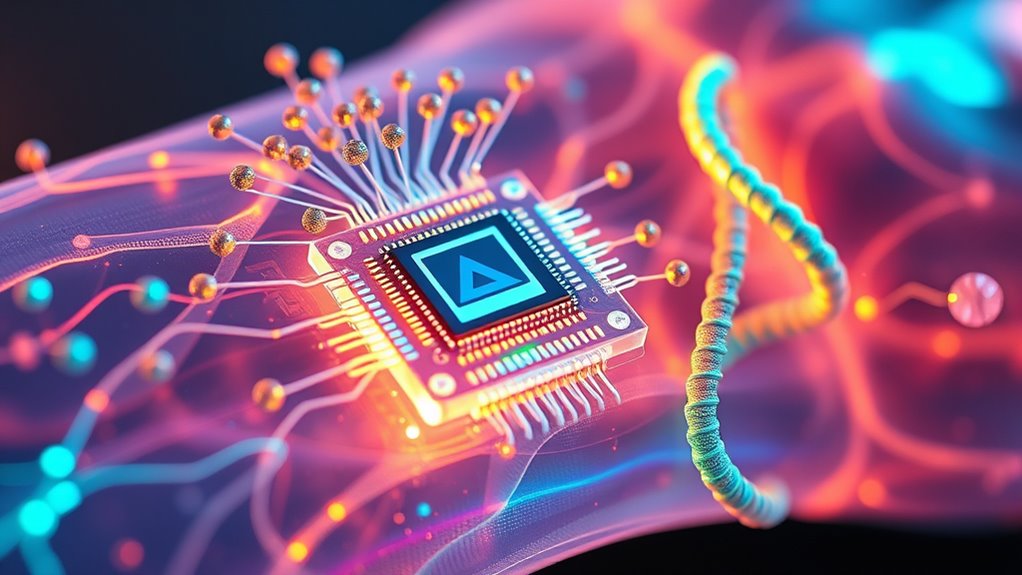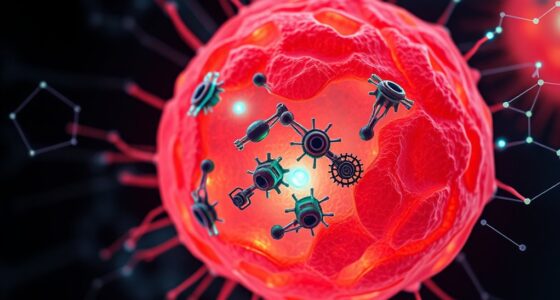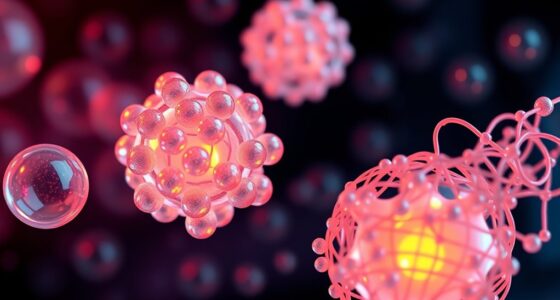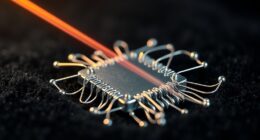Personalized medicine uses your genetic information to tailor treatments specifically for you, improving effectiveness and reducing side effects. Nanotechnology plays a key role by creating tiny particles that deliver drugs directly to diseased cells, like cancer, while sparing healthy tissue. It also enhances diagnostic tools and imaging for early detection. Understanding how these technologies work together can show you the exciting ways healthcare is evolving—if you keep exploring, you’ll discover even more groundbreaking advances.
Key Takeaways
- Nanotechnology enables targeted drug delivery systems that personalize treatments based on an individual’s genetic profile.
- Engineered nanoparticles improve diagnostic accuracy and early detection through advanced imaging and biomarker sensors.
- Combining genetic profiling with nanotech facilitates customized therapies, reducing trial-and-error in treatment plans.
- Nanoparticles can penetrate tumors and tissues effectively, enhancing personalized cancer treatments with minimal side effects.
- Ongoing research and regulatory development are essential to ensure safe, effective integration of nanotech in personalized medicine.
The Foundations of Personalized Medicine
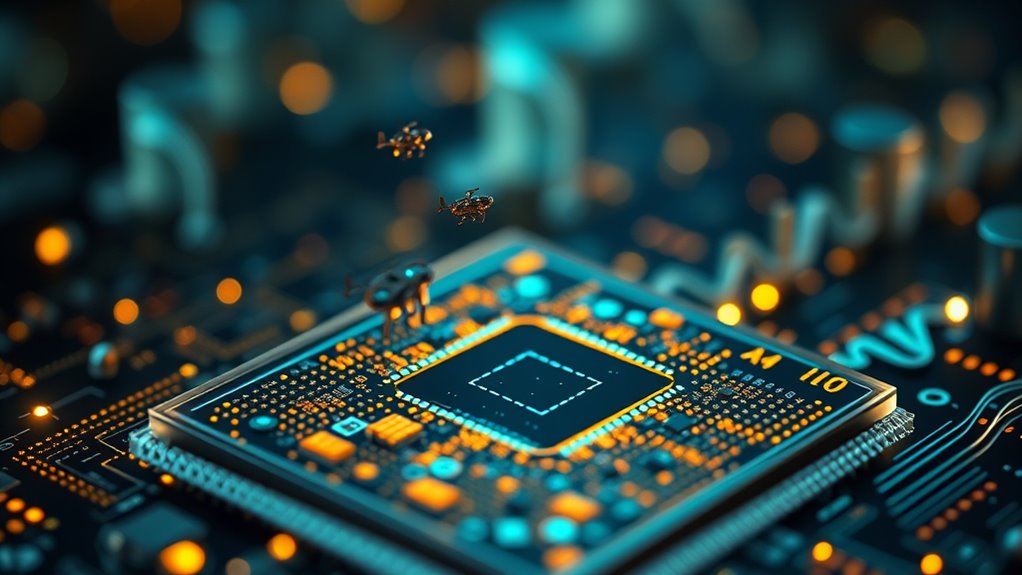
Personalized medicine is built on the idea that treatments should be tailored to individual patients rather than applying a one-size-fits-all approach. You’re at the center of this concept, which considers your unique genetic makeup, lifestyle, and environment. Researchers analyze your DNA to identify genetic variations that influence how you respond to specific treatments. This allows doctors to select therapies that are more effective and less likely to cause side effects. By understanding your genetic profile, personalized medicine aims to predict disease risk and customize prevention strategies. This foundation shifts healthcare from reactive to proactive, focusing on your individual needs. It’s a move toward more precise, effective care, where treatments are designed with your specific biological makeup in mind. Additionally, advances in genomic analysis enable more comprehensive understanding of individual health profiles, further supporting personalized treatment approaches.
How Nanotechnology Enhances Drug Delivery

Nanotechnology has revolutionized drug delivery by enabling the creation of tiny, engineered particles that can precisely target specific cells or tissues. These nanoparticles are designed to carry medication directly to the affected areas, reducing side effects and increasing effectiveness. You can think of them as smart delivery vehicles that navigate your body’s complex systems, bypassing healthy tissues and focusing on diseased cells. This targeted approach allows for lower drug doses, minimizing toxicity. Additionally, nanotechnology enhances the stability and solubility of drugs, ensuring they remain effective until they reach their destination. The use of contrast ratio in imaging techniques further improves the visualization of targeted areas, aiding in more accurate treatment. As a result, treatments become more efficient and personalized, aligning with your unique biological makeup. Overall, nanotechnology transforms conventional drug delivery into a more precise, controlled process that benefits your health and recovery.
Genetic Profiling and Treatment Customization

Advances in genetic profiling allow healthcare providers to analyze your unique DNA, revealing specific genetic variations that influence how your body responds to different treatments. By understanding these genetic differences, your doctor can tailor medications and therapies to maximize effectiveness and minimize side effects. You might find that certain drugs work better for you or that some treatments are unsuitable due to genetic sensitivities. This personalized approach guarantees you receive the most appropriate care based on your genetic makeup. As a result, treatments become more precise, reducing trial-and-error prescribing and improving health outcomes. Genetic profiling also helps identify risks for future diseases, enabling preventative measures. Genetic analysis enhances the precision of personalized medicine by uncovering insights into individual health risks. Overall, this customization empowers you with targeted, efficient care, transforming traditional one-size-fits-all medicine into a more personalized and effective healthcare experience.
Nanoparticles in Cancer Therapy
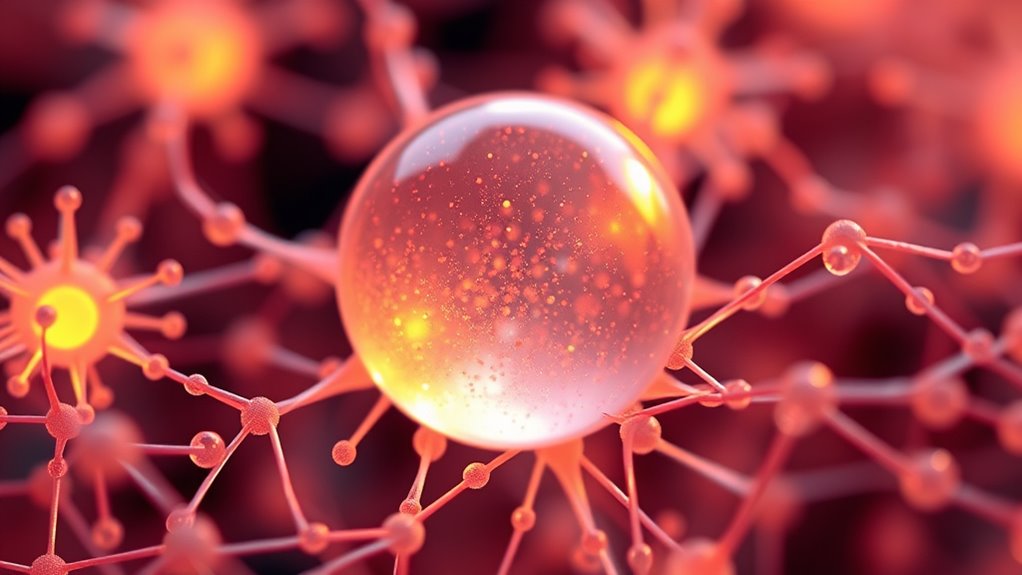
Nanoparticles have emerged as a groundbreaking tool in cancer therapy, offering targeted treatment options that can substantially improve patient outcomes. You can deliver drugs directly to cancer cells, minimizing damage to healthy tissue. These tiny carriers can be engineered to recognize specific tumor markers, ensuring precise targeting. Nanoparticles enhance drug solubility and stability, allowing for higher effective doses. They also enable controlled drug release, maintaining therapeutic levels over time. Some nanoparticles are designed to penetrate deep into tumors, overcoming barriers that limit traditional therapies. By concentrating treatment at the tumor site, nanoparticles reduce the overall dose needed and lower side effects. This precision approach makes cancer treatments more effective and personalized, aligning with your specific tumor profile and improving overall prognosis. Additionally, ongoing research in AI-driven nanoparticle design is paving the way for even more sophisticated and adaptive cancer therapies.
Reducing Side Effects With Targeted Treatments

Because targeted treatments deliver drugs directly to cancer cells, they markedly reduce the side effects often associated with traditional therapies. Instead of affecting healthy tissue, these treatments focus on specific markers on cancer cells, sparing your normal cells. This precision minimizes common issues like nausea, fatigue, and hair loss. As a result, you may experience fewer complications and a better quality of life during treatment. Targeted therapies also often work faster and more effectively against tumors, reducing the need for high doses that cause side effects. By focusing treatment on cancer cells alone, you’ll have a more tolerable experience, with less damage to your body. This approach is transforming cancer care, making treatments safer and more personalized to your specific condition. Additionally, predictive analytics can help tailor therapies even further by analyzing patient data to forecast treatment outcomes.
Advances in Diagnostic Tools Using Nanotech
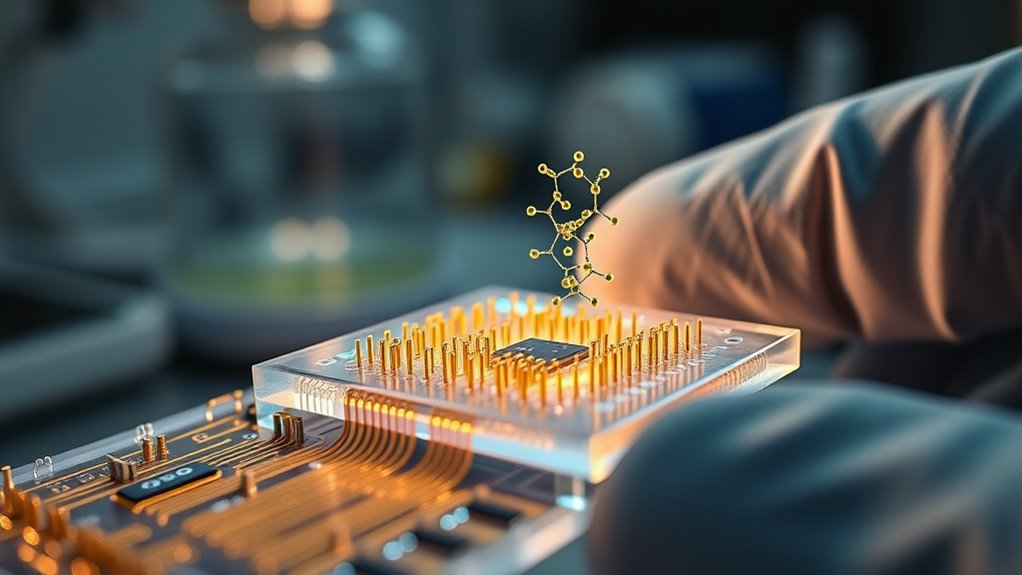
Recent developments in nanotechnology have revolutionized diagnostic tools, enabling doctors to detect diseases at much earlier stages. You now have access to nanoscale sensors that can identify biomarkers with incredible sensitivity. These tiny devices can analyze blood, saliva, or tissue samples quickly and accurately, catching illnesses like cancer or infections before symptoms appear. Nanotech-based imaging agents improve resolution in MRI or CT scans, revealing abnormalities with greater detail. Lab-on-a-chip systems integrate multiple testing processes into compact devices, providing rapid results at the point of care. As a result, diagnoses become faster, more precise, and less invasive. This progress allows you to start personalized treatments sooner, improving outcomes and reducing side effects. Nanotech-driven diagnostics are transforming early detection and personalized healthcare.
Ethical and Privacy Considerations
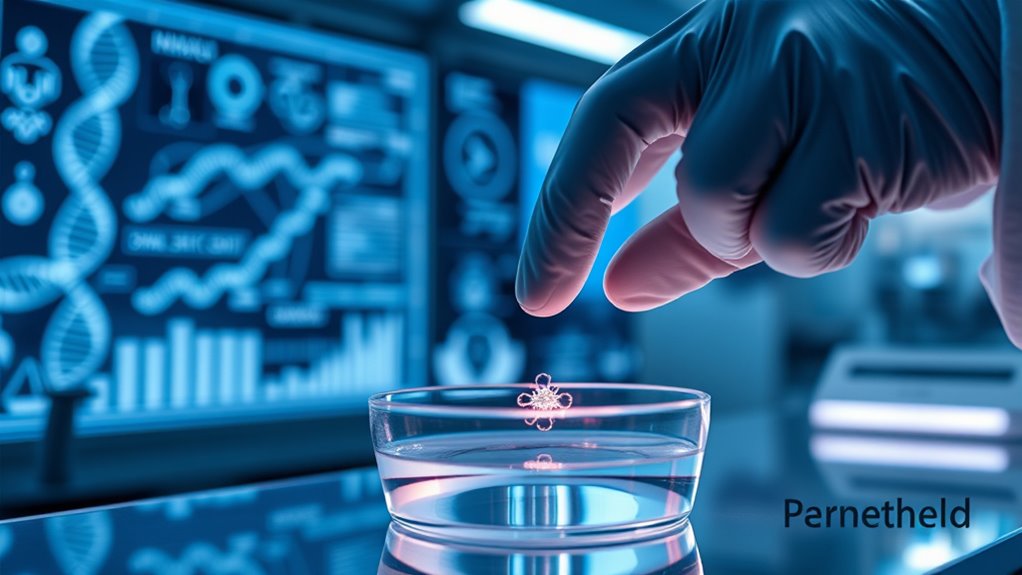
As nanotechnology becomes increasingly integrated into personalized medicine, ethical and privacy concerns naturally arise. You need to be aware that detailed genetic and health data will be collected and stored, raising risks of misuse or breaches. Protecting patient confidentiality becomes more complex with nanoscale devices capable of continuous monitoring. You might worry about informed consent, especially when data could be shared across multiple platforms or used for purposes beyond treatment. There’s also the question of equitable access—will advanced nanotech treatments be available to all, or only to a privileged few? Ensuring data security and maintaining patient trust are essential. As you navigate these developments, balancing innovation with respect for individual rights remains critical to ethical progress. Additionally, understanding the flat iron bike market can offer insights into how emerging technologies are priced and adopted, which could influence the accessibility of future medical nanotech solutions.
Current Challenges and Limitations
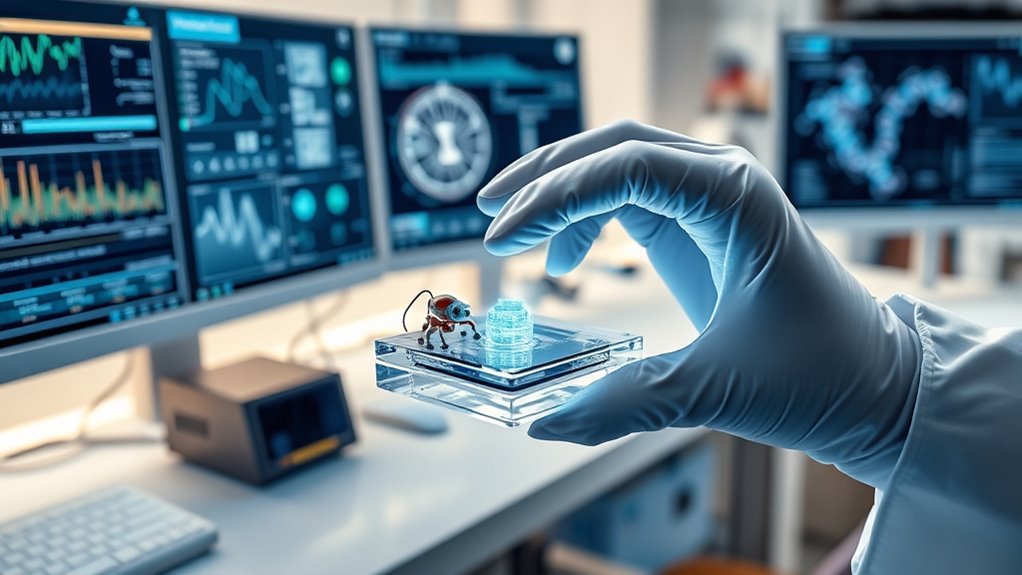
Despite the promising potential of nanotechnology in personalized medicine, several significant challenges limit its current application. First, manufacturing nanoscale devices with consistent quality and reproducibility remains difficult, which affects safety and efficacy. You also face hurdles in understanding how nanomaterials interact with biological systems, raising concerns about toxicity and unintended side effects. Regulatory frameworks are still evolving, leaving many nanotech therapies in limbo and delaying clinical adoption. Additionally, high development costs and complex fabrication processes make widespread use economically challenging. You must also consider ethical issues, such as long-term impacts and environmental risks, which remain poorly understood. Moreover, the lack of comprehensive regulatory resources can hinder the translation of nanotechnologies from research to clinical practice. These obstacles slow down progress, requiring careful research, regulation, and investment to realize the full potential of nanotechnology in personalized medicine.
Future Prospects and Emerging Trends

The future of personalized medicine with nanotechnology looks promising as emerging trends promise to overcome current limitations and accelerate clinical adoption. You can expect innovations that improve targeting accuracy, reduce side effects, and enable real-time monitoring of treatments. Advances like smart nanoparticles that respond to specific biological signals, integration of artificial intelligence for data analysis, and scalable manufacturing techniques will drive progress. Additionally, personalized nanomedicine will likely become more accessible, affordable, and tailored to individual genetic profiles. Key trends include:
Emerging nanotech trends will revolutionize personalized medicine with smarter, safer, and more accessible treatments.
- Development of multifunctional nanodevices for diagnostics and therapy
- Utilization of biomimetic nanoparticles for better biocompatibility
- Incorporation of machine learning to optimize treatment strategies
- Expansion of gene editing tools combined with nanotechnology
- Enhanced regulatory frameworks to guarantee safety and efficacy
Advances in nanotechnology are also paving the way for more effective delivery systems that can precisely target diseased cells while sparing healthy tissue.
Real-World Applications and Case Studies
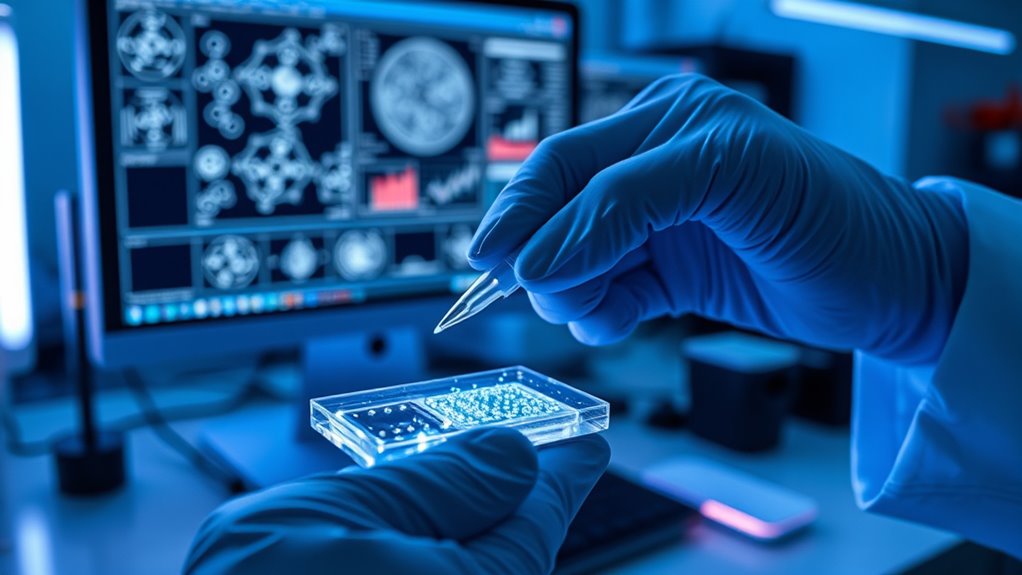
Real-world applications of nanotechnology in personalized medicine demonstrate tangible benefits, from targeted cancer therapies to advanced diagnostic tools. For example, nanoparticle-based drug delivery systems allow you to target tumors precisely, minimizing side effects and increasing treatment efficacy. In diagnostics, nanotech-enhanced imaging enables earlier detection of diseases like Alzheimer’s or infectious illnesses, improving patient outcomes. Case studies reveal how these innovations have transformed patient care; one involves gold nanoparticles used to identify cancer cells with high accuracy. Another highlights liposomal formulations that deliver chemotherapy drugs directly to tumors, reducing toxicity. These real-world examples show how nanotechnology’s integration into personalized medicine makes treatments more effective, safer, and tailored to individual genetic profiles, ultimately advancing healthcare delivery. Additionally, understanding divorce process in various states can inform healthcare professionals about legal considerations affecting patient care and family planning decisions.
Frequently Asked Questions
How Cost-Effective Is Personalized Nanomedical Treatment for Patients?
Personalized nanomedical treatments can be cost-effective in the long run because they target specific issues precisely, reducing unnecessary procedures and side effects. You might spend more upfront on advanced technology, but it often leads to faster recovery and better outcomes. As the technology advances and becomes more widespread, costs are expected to decrease, making these treatments more accessible and affordable for you and others in the future.
What Are the Regulatory Hurdles for Approving Nanotech-Based Therapies?
Charting the regulatory maze for nanotech-based therapies is like threading a needle through a storm. You face hurdles such as proving safety in tiny, complex particles that can behave unpredictably, and establishing manufacturing standards that keep quality in check. Regulatory agencies demand rigorous testing, transparent data, and clear guidelines, making approval a painstaking process. Yet, overcoming these obstacles is essential to open the full potential of cutting-edge nanomedical treatments.
How Does Personalized Medicine Address Rare Genetic Disorders?
You can see that personalized medicine tailors treatments to an individual’s unique genetic makeup, making it highly effective for rare genetic disorders. By analyzing your genetic profile, healthcare providers identify specific mutations responsible for your condition. This targeted approach allows you to receive therapies designed just for you, improving outcomes and reducing side effects. Personalized medicine offers hope for those with rare disorders who previously had limited or no effective treatment options.
Can Nanotechnology Be Used for Non-Invasive Disease Monitoring?
Yes, nanotechnology can be used for non-invasive disease monitoring. You can have tiny nanosensors that detect specific biomarkers in your blood or other fluids, providing real-time information about your health. These sensors are small enough to be minimally invasive or even completely non-invasive, offering continuous monitoring without the need for frequent blood tests or biopsies. This innovative approach helps catch health issues early and improves treatment outcomes.
What Are the Long-Term Safety Implications of Nanomaterials in Medicine?
Safety concerns swirl around the long-term use of nanomaterials in medicine. You might worry about potential toxicity, environmental impact, or unintended interactions within your body. Researchers are diligently designing nanomaterials to minimize risks, but uncertainties remain. It’s essential to stay informed about ongoing studies and regulatory updates. Ultimately, responsible research and rigorous testing help guarantee that nanotechnology advances safely, protecting your health now and in the future.
Conclusion
As you explore personalized medicine and nanotechnology, remember they’re the keys unraveling tailored treatments like a master craftsman shaping a unique masterpiece. While challenges remain, these innovations hold the promise of transforming healthcare into a precise, efficient journey. Embrace the future, knowing that with each breakthrough, you’re witnessing the dawn of a new era—where medicine is not just a remedy but a personalized symphony tuned perfectly to you.
